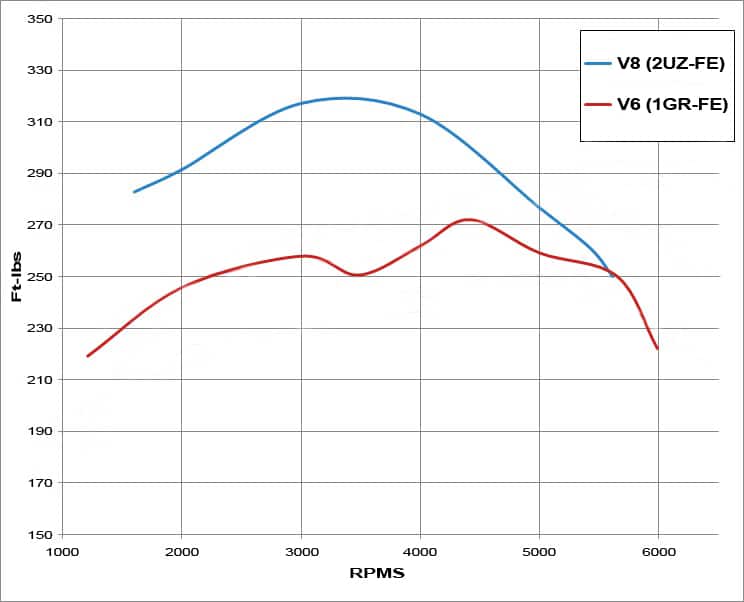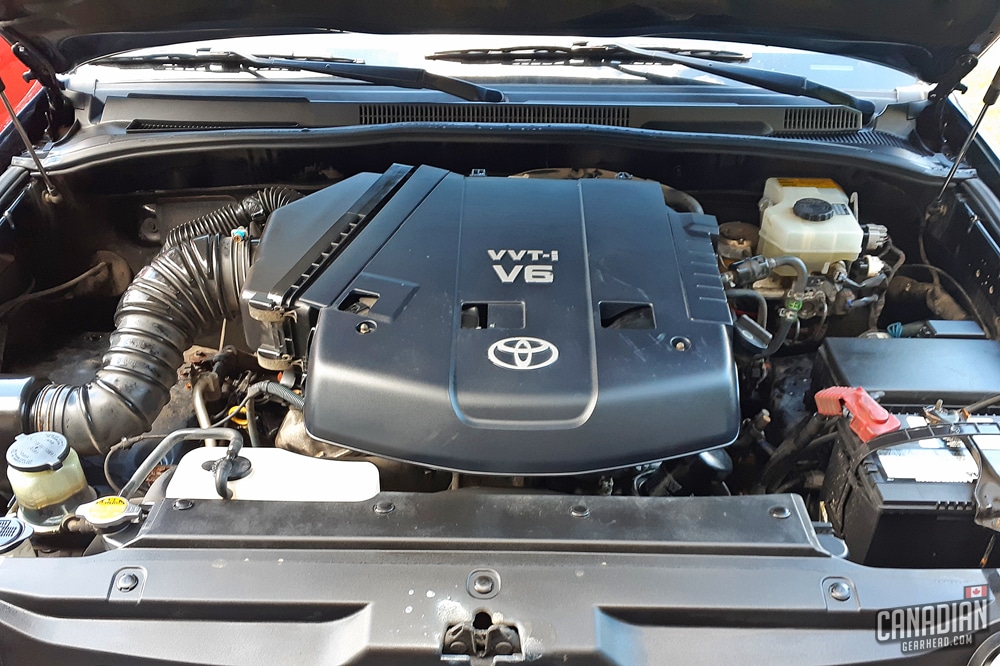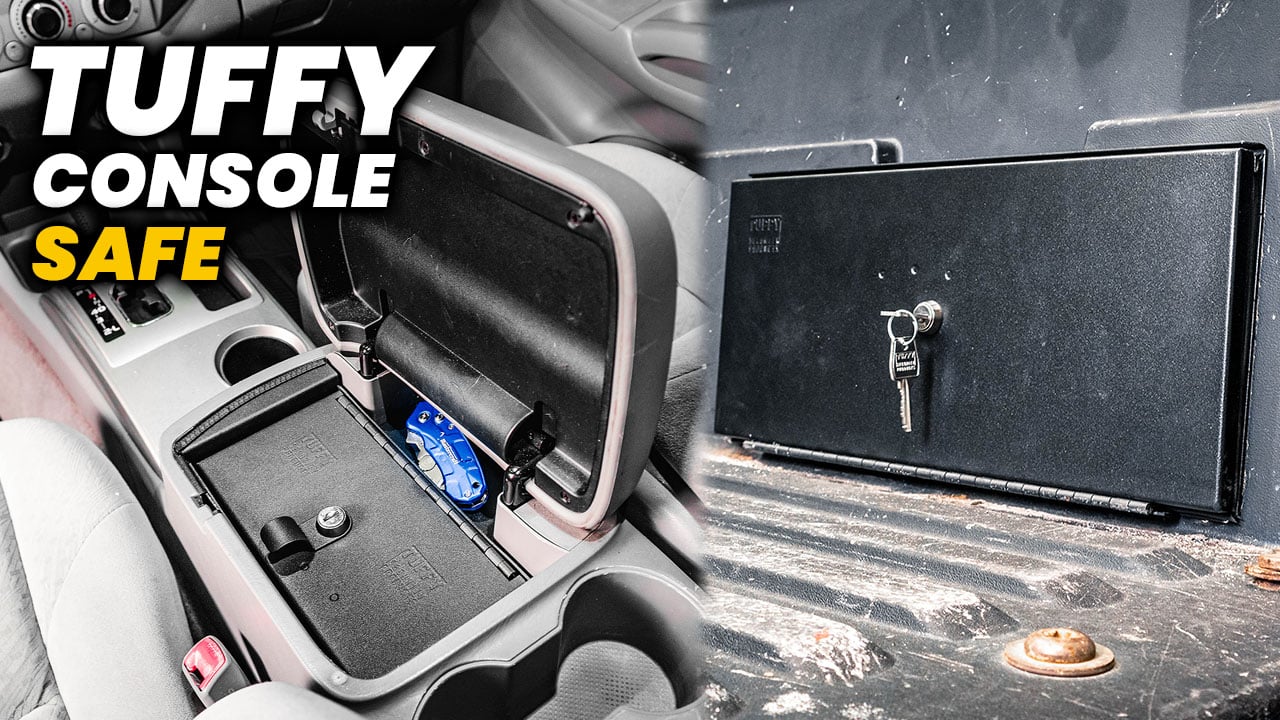There are 3 things that are often too polarizing to talk about with others: politics, religion, and whether the V6 or V8 is a better engine in the 4th gen 4runner. At least that’s what it seems like if you’ve spent any time on the 4runner forums online.
The reality is that both the 4.0 V6 and 4.7 V8 are great performing and reliable engines. The V6 is more fuel-efficient and requires slightly less maintenance while the V8 is smoother and offers better performance. You can’t go wrong with either – it all depends on how you use your 4runner.
There are plenty of fans of both the 1GR V6 and the 2UZ V8 and most of them can’t be convinced that the other is just as good. The truth is that both engines can perform every task you would use an SUV for whether it’s off-roading, towing, or commuting. They’re both better at some things and worse at others.

As a V8 owner myself, I’m going to try to make this as informative and non-biased as possible. It’s worth noting that I have driven both the V6 and V8 4runners personally.
Before we dig deeper into the comparison of these two awesome motors, take a look at this table that shows the strong points of each one:
| 4.0L V6 (1GR-FE) | 4.7L V8 (2UZ-FE) |
|---|---|
| 2 MPG better fuel economy | Up to 25 more horsepower and 48 ft-lbs more torque |
| Easier maintenance | Less vibration and noise |
| 2WD setting on 4×4 models | 2,000 lb more towing capacity |
Now let’s go further into detail to see how each engine compares in different situations.
Performance
It might be hard for V6 owners to accept, but the V8 does in fact offer better performance numbers. There was a change to the SAE protocols for the way manufacturers measure the horsepower of their engines in 2004 and Toyota implemented it in 2006. This meant that while the engines still performed the same, both the V6 and V8 were rated at lower horsepower and torque in the later years.
Some people like to use these numbers in their favor by comparing the newer rating of the V8 with the older rating of the V6. This makes it seem as though they’re much closer in performance, but it is not a fair or accurate statement. Here are the actual numbers to compare the 2 engines:
| 4.0L V6 (1GR-FE) | 4.7L V8 (2UZ-FE) 2003-2004 | 4.7L V8 (2UZ-FE) 2005+ with VVT-I | |
|---|---|---|---|
| Horsepower | 245 hp at 5200 RPM | 235 hp at 4800 RPM | 270 hp at 4800 RPM |
| Torque | 282 ft-lbs at 3400 RPM | 320 ft-lbs at 3400 RPM | 330 ft-lbs at 3400 RPM |
As you can see, Toyota added VVT-I (variable valve timing with intelligence) to the V8 as well as a slightly higher compression ratio from 9.6:1 to 10:1. This resulted in a bump from 235 hp to 270 hp and 320 ft-lbs to 330 ft-lbs.
The V6 does indeed make 10 hp more than the older V8 models, although it needs to rev higher in order to produce it. It’s clear to see that both the V8s made quite a bit more torque than the V6.
What’s even more interesting is the fact that the V8 makes 80% of its peak torque at just 1100 RPM. That might not seem like a big deal on paper, but it makes a noticeable difference when driving a V8 4runner. Take a look at the torque curve between both engines:

Another thing worth mentioning is that the 2005+ model V6 4runners were upgraded to a 5 speed transmission – that gearing helps their performance. All V8 4runners came with the 5 speed.
The 4×4 systems on the V6 and V8 models are different as well. The V6 4runners offer 2WD along with all of the 4×4 settings while the V8 has full time AWD with the option of 4 low. This can be a good or bad thing depending on your opinion and how you use your 4runner.
Driving around on a dry summer day in 2WD is simple and efficient. Others might prefer the ability to do nothing more than shift into “Drive” in even the worst winter weather.
Seat-of-the-pants feel is obviously very subjective, but most people can feel the difference between the V6 and V8 when driving around town and especially when merging onto a highway. The added torque of the V8 means it doesn’t need to work nearly as hard or rev as high in order to accelerate.
The 4.7 V8 clearly takes the win in this category.
This article was originally posted on Canadiangearhead.com. If you’re reading this anywhere else, it was stolen and reused without consent.
Reliability
We know that Toyota’s V6s are famously well built but are the V8 4runners reliable?
Both the 1GR-FE V6 and 2UZ-FE V8 are incredibly reliable engines. You really can’t go wrong with either and as long as you maintain them, they’ll easily last for 300,000+ miles. No engine is perfect though, and both of them do have a couple of issues that have been documented over the years.
AIP problems with the 2UZ V8
The air injection pump on the 2005+ V8s has been known to fail and can result in a very expensive fix if you take it to the dealership. There are cheap bypasses available that will disable the system to avoid any future problems from arising.
In the event that the ECU goes into limp mode due to the flaps being stuck open, there are block off plates also available. Combining these with the bypass will trick the ECU into thinking everything is functioning normally.
Cracked exhaust manifolds on the 2UZ V8
Perhaps one of the most common 4th gen 4runner problems is a cracked exhaust manifold. It happens to a lot of the v8s and creates an annoying (and embarrassing) ticking sound.
The good news is that it rarely causes a big enough leak to trigger a Check Engine light or diagnostic trouble code. The engine will still run fine, it just makes a noise. Because of that, a cracked manifold shouldn’t really be considered a reliability issue as it won’t leave you stranded on the side of the road or cause a failure.
You can read more about cracked exhaust manifolds and how I fixed mine with a set of Doug Thorley headers in this post:
Head gasket failure in the 2003-2004 model IGR V6
The V6 4runners are not completely immune to problems either. The most noteworthy is the head gasket failures in early model year 4th gens. From what I understand, these failures were due to a manufacturer defect in the gasket and were remedied by upgrading it in the 2005+ models. It wasn’t an issue with the design of the engine, just a weak part that needed to be improved.
Aside from the above mentioned issues, both engines are rock solid. The fact that Toyota used these engines in other platforms for many years proves that they’re dependable. The 1GR V6 was used in the 4runner, Tacoma, FJ Cruiser, and Tundra. The 2UZ V8 was used in even more models – the 4runner, Tundra, Sequoia, Land Cruiser, and the Lexus GX 470 and LX 470.
It’s interesting to note that Toyota only offered the V8 in the Lexus models. One could guess that this is because of its higher performance and/or smoother operation.
It’s also worth mentioning that all of the famous “Million Mile Tundras” were equipped with the 4.7L V8 and not the 5.7L. There is speculation that the Japanese-built 4.7 in the 4runner and Lexus has stronger forged connecting rods than the American built 4.7 found in the Tundra and Sequoia.
If that is indeed true, it’s really saying something if the “weaker” version of this engine is surviving 1 million miles in a pickup truck.
With one common issue for each, reliability is a draw between the V6 and V8.

Maintenance
Both the V6 and V8 engines require very little maintenance to keep them happy and healthy. It’s really just a matter of keeping the fluids clean and that’s it.
The location of the oil filter on the V6 allows it to be reached easily without removing the skid plate unlike the V8 so it gets a bonus point there.
The biggest difference between these engines is that the V6 has a timing chain while the V8 uses a belt. That timing belt needs to be replaced (typically along with the water pump while you’re in there) roughly every 100,000 miles.
This is less of a big deal than people make it out to be – how often do you log 100,000 miles? Yes, it’s an added cost, but not one that you’ll need to deal with very often at all.
Surprisingly, some people have chosen to gamble by not replacing the timing belt. Failures are rare and haven’t resulted in valve damage in both VVT-I and non-VVT-I models (despite them being considered “interference” engines). Of course, it’s recommended to stick with the proper service interval if you care about longevity.
While both require very little attention, the V6 takes the win here because of the timing belt replacement on the V8.
Fuel Economy
Let’s be honest – if fuel economy is a big priority for you, you probably won’t be shopping for any version of the Toyota 4runner. None of them are particularly good on gas. But while both are bad, the V8 is worse.
| 4.0L V6 (1GR-FE) | 4.7L V8 (2UZ-FE) | |
|---|---|---|
| City | 16 MPG | 15 MPG |
| Highway | 21 MPG | 19 MPG |
| Combined | 18 MPG | 17 MPG |
2 MPG worse, to be exact. Gas mileage is heavily dependent on the driver though so this isn’t necessarily as simple as that. Having a heavy foot can make a big difference with both engines. Some might say the rewarding sound of the V8 can cause you to have a heavier foot but again, everyone is different.
The clear advantage here goes to the V6.
Towing
As with any other typical use of an SUV, you can tow with both the V6 or the V8 just fine. Even with its lower 5,000 lb rating, the V6 4runners are on par with the other mid size SUVs that it competes with.
The V8 4runners really shine when it comes to towing. With a 2,000 lb higher tow rating (7,000 lbs) they can certainly tow more, or more likely, tow the same load but much easier.
That same torque curve that we saw in the graph above is what makes the biggest difference. All of that extra torque is delivered right in the RPM range that you’ll be at while accelerating with a heavy load. In order to do pull the same trailer in the same conditions, the V6 needs to work harder and at a higher RPM.
The engine isn’t the only reason why the V8 4runners have a higher tow rating though. They also come equipped with a hitch that’s rated for more weight and a transmission cooler.
The thing is though, if you tow 7,000 lbs regularly, even a V8 4runner might not be the best tool for the job. Power might not be an issue but they’re still a lighter weight SUV with a relatively short wheelbase – and because of that, a full size pickup like a Tundra will do a better job of controlling the load.
Think of the 4runner’s towing ability as something you can use occasionally or rely on in a pinch, but for regular use you might want to reconsider a bigger truck.
With all that said, the V8 outperforms the V6 in every way when it comes to towing so it’s no surprise that it gets the win here.

Character and overall feel
This last topic is one that I feel is often overlooked when comparing the V6 and V8 4th gen 4runner. Specs, ratings, and performance tests all have their place and are very helpful when deciding on which model to buy.
But having driven both models personally, there are certain things that just don’t show up on paper. They’re heard and felt – and they’re a part of the driving experience that isn’t likely to show up in test results.
Sound
There is a real difference between the sound of a V6 and a V8 4runner. It might be less apparent while they retain their relatively quiet factory exhausts, but when they’re upgraded, the difference is night and day.
Putting a cat back exhaust on the V6 doesn’t necessarily sound bad, but it won’t exactly get compliments from strangers. Upgrading the exhaust on a V8 4runner however, will release a deep growl that many unsuspecting bystanders would never expect to come from a small Toyota SUV. The 2UZ is a beautiful sounding engine and it really makes you feel like you’re driving something special.
Aside from the exhaust note, the V6 is a noticeably louder engine. They’re known for having more of a ticking and tapping sound that is louder than the V8.
Smoothness
Toyota did a good job of making all 4th gen 4runners feel smooth and refined. The V8 is indeed smoother than the V6 as it runs through the rev range though. Many people believe that this is the sole reason why Toyota only used the V8 in the Lexus models.
Amount of effort required
Another difference that you’ll notice when comparing the way the V6 and V8 drive is the amount of effort needed to get the 4runner up and moving. The V8 does so with ease and feels like it’s never really working hard. Unlike the V8, the V6 requires more than just a light tap on the throttle to get up to speed quickly.
For those with reliability on their mind, an engine that doesn’t need to work hard is more likely to last longer. In the case of these Toyotas though, there’s no reason to believe either engine is more reliable than the other – they’re both great in that department.
When loaded down with a bunch of passengers and excessive weight, the V6 4runner might struggle to climb long uphill grades. In the same situation, the V8 won’t even break a sweat. Both will get the job done but the V8 will do so at a lower RPM and temperature, with less sound and vibration.
Rarity and future value
Every generation of 4runner has offered a V6 engine. V8s however, can only be found in the 2003-2009 models. Out of 5 generations, the 4th Gen is the only one to have a V8 engine. And with the direction things seem to be heading in the auto industry, Toyota will never put a V8 engine in the 4runner ever again.
This makes them very special. If the collector car market tells us anything, it’s that limited versions of popular vehicles will continue to stand out and be sought after. The V8 4runner is an unsuspecting little hot rod and because of that, has potential to be collectible in the future.
We’re already seeing evidence of the V8 4runners becoming desirable. Take a look at the used market and there are very few listed for sale at any given time. The ones that you find often have a fairly high asking price. Is this a sign that the values have already bottomed out and will begin to climb in the future? We’ll just have to wait and see.
Again, there’s nothing wrong with the V6 models. It’s just that they blend in with all the other 4runner generations as well as all the other platforms like the Tacoma and FJ Cruiser – they were popular and they all had a V6.
For a much more biased opinion on the matter, make sure to check out this video:
Final word
In the end, you can’t go wrong with buying any model of 4th Gen 4runner with any options and any engine. They’re all built really well and are both functional and reliable. Depending on your usage and priorities, you might find that one engine will suit you more than the other.
It’s also worth noting that all of these comparisons are factoring in the 4runner being stock and unmodified. The V8 models will be able to handle the extra weight from bigger tires, armor, and accessories better than the V6 – and that should be considered if you have plans to build your future 4runner into a beast one day.
If this comparison has taught us anything, it’s that the general statements about these engines in the 4th Gen 4runner are true: If you care about fuel efficiency and want the easiest option to maintain, get the V6. If you prefer the extra power and added character, the V8 is the way to go

Tim is the creator of Canadian Gearhead. His experience with auto detailing and working for Toyota shows through all of the articles posted here. He runs the Canadian Gearhead site and YouTube channel full-time now and currently owns a 2007 4runner, 2006 Tacoma, and 1991 MR2. Read more about Tim:





Leave a Reply